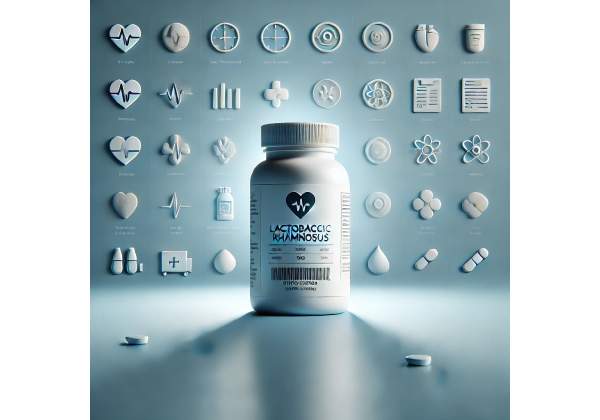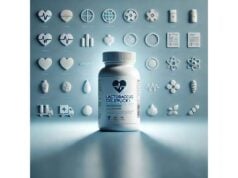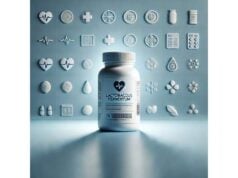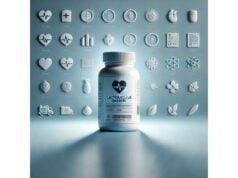
Lactobacillus rhamnosus (often updated taxonomically as Lacticaseibacillus rhamnosus) is one of the most researched probiotics in children and adults. Its best-known strain, LGG (ATCC 53103), has been studied for preventing antibiotic-associated diarrhea, supporting upper respiratory health in high-exposure settings, and helping some digestive complaints. Other strains, such as GR-1, are used together with companion species for women’s urogenital support. Like all probiotics, results are strain-specific and depend on dose, timing, and your goal. This people-first guide summarizes how L. rhamnosus works, where the evidence is strongest, how to choose and use a product, who stands to benefit most, and when to be cautious. You’ll also find practical dosing ranges in colony-forming units (CFU), tips for reading labels, and a concise evidence snapshot to help you set expectations and measure progress.
Fast Facts
- Best-supported uses include preventing pediatric antibiotic-associated diarrhea and reducing respiratory infection days in select groups.
- Typical daily dose: 1–20 billion CFU; higher ranges (5–40 billion CFU) are often used during antibiotic courses.
- Not helpful for every condition; high-quality trials found no benefit for acute viral gastroenteritis in children.
- Mild gas or bloating can occur; avoid use without medical guidance if severely immunocompromised or if you have a central venous catheter.
Table of Contents
- What is Lactobacillus rhamnosus and how it works
- Benefits: what results to expect
- How to take it: dosage and timing
- Who benefits most: real-world scenarios
- Safety, side effects, and who should avoid
- Evidence snapshot: what studies show
What is Lactobacillus rhamnosus and how it works
Lactobacillus rhamnosus is a lactic-acid–producing species found in the human gut and in fermented foods. In supplements, it’s delivered as live microorganisms measured in CFU. Crucially, benefits are strain-specific. Labels should list a code after the species name. Examples include:
- LGG (ATCC 53103): the flagship strain for pediatric antibiotic-associated diarrhea (AAD) prevention and respiratory season support.
- GR-1: most commonly paired with Lactobacillus reuteri RC-14 for women’s urogenital applications.
- Other research strains appear in blends, but most real-world guidance revolves around LGG for digestive and immune-related outcomes.
How it may help
- Colonization and resilience: L. rhamnosus tends to tolerate acid and bile, improving survival through the stomach and small intestine so it can transiently inhabit the gut while you take it.
- Barrier support: By influencing tight junctions and mucus, it can help stabilize gut barrier function in some contexts.
- Immune modulation: Interaction with gut-associated immune tissue may nudge responses toward balance—useful when you want robust first-line defenses without excessive inflammation.
- Pathogen suppression: Acidification of local environments and production of microbe-inhibiting compounds help limit overgrowth of less friendly species, particularly during and after antibiotic courses.
- Carbohydrate fermentation: Gentle production of organic acids can influence stool water content and bowel regularity for some users.
What makes it different
- Depth of child-focused evidence: Compared with many probiotics, L. rhamnosus (especially LGG) has a long track record in pediatrics.
- High-exposure settings: Daycare, classrooms, and households with frequent colds are common use cases in which LGG has been studied for respiratory outcomes.
- Programmatic use: Because outcomes are modest on average, L. rhamnosus works best when inserted into a larger plan—antibiotics timing, sleep, hand hygiene, fiber intake—rather than used in isolation.
Limits to remember
- Not all strains are interchangeable. LGG data do not automatically apply to unlabeled products or to GR-1.
- Condition-specific efficacy. For example, high-quality trials show no benefit for acute viral gastroenteritis treatment in children; don’t expect probiotics to shorten a stomach bug once it’s underway.
- Consistency matters. Missed doses reduce the chance of seeing a measurable effect during short trial windows.
Benefits: what results to expect
Prevention of pediatric antibiotic-associated diarrhea (AAD)
When children take antibiotics, the gut ecosystem shifts, and diarrhea can develop within days. LGG is one of the few strains repeatedly studied for reducing the risk of AAD in pediatrics. Benefits are most likely when:
- You start LGG the same day as the antibiotic.
- You use a meaningful daily CFU (often 5–40 billion CFU across the day during the antibiotic course).
- You continue for 7–14 days after the antibiotic ends.
Expectations: fewer children develop AAD and, among those who do, episodes may be shorter. Effects are average; some will not respond even with good adherence.
Upper respiratory support in high-exposure settings
Multiple randomized trials and pooled analyses suggest LGG can reduce the number of days with respiratory symptoms or the incidence of episodes in settings like daycare or dense workplaces. Gains tend to be modest but meaningful when you face frequent exposures. LGG is not a substitute for vaccination, sleep, or hand hygiene; think of it as an add-on that nudges probabilities.
Digestive comfort during and after antibiotics
Beyond AAD prevention, many families use LGG to smooth digestive side effects while on antibiotics—less cramping, less urgency, and a quicker return to normal after the course. Results vary and are influenced by diet (particularly soluble fiber) and hydration.
Acute gastroenteritis treatment in children
Well-designed trials in North America found no benefit of LGG for treating acute viral gastroenteritis once illness has begun. This matters for expectations: LGG is better positioned for prevention (AAD) and maintenance than for treating a stomach bug that’s already underway.
Women’s urogenital support with GR-1 and RC-14
The GR-1 strain of L. rhamnosus, often combined with L. reuteri RC-14, has been used as adjunct support for bacterial vaginosis and to help maintain a favorable flora. Results vary by study design and population. If you consider this combination, align with your clinician and use it alongside standard care, not in place of indicated treatment.
All-ages general gut support
Adults and children sometimes report less gas and more regular stools after a few weeks of LGG. These nonspecific improvements are plausible but not guaranteed. They tend to be stronger when you also increase fermentable fiber, manage stress, and keep mealtimes steady.
Bottom line: L. rhamnosus offers its clearest, most actionable benefits for preventing pediatric AAD and reducing respiratory sick days in select, high-exposure groups. It is not a universal fix; benefits are modest and depend on the right strain, dose, and timing.
How to take it: dosage and timing
Choose the right strain for your goal
- LGG (ATCC 53103): preferred for pediatric AAD prevention and respiratory season support.
- GR-1: primarily for women’s urogenital support, most often combined with L. reuteri RC-14.
- If the label lists only “L. rhamnosus” without a strain code, you cannot assume it matches the evidence.
Daily dose ranges
- Everyday digestive or immune support: 1–10 billion CFU daily for 4–8 weeks, then reassess.
- During antibiotics (children or adults): 5–40 billion CFU daily in divided doses for the entire antibiotic course, plus 7–14 days afterward.
- Respiratory season programs: 1–10 billion CFU daily for 8–12 weeks during the peak exposure window.
- Women’s urogenital support (GR-1 with RC-14): follow the product’s combined regimen; typical programs last 4–12 weeks and are adjuncts to clinician-directed care.
Timing with meals and medicines
- Take L. rhamnosus with meals or shortly after to improve survival through stomach acid.
- Separate from oral antibiotics by 2–3 hours to limit kill-off.
- Keep your daily schedule consistent; sporadic use weakens results in short trials.
Forms and storage
- Powders and capsules are common; drops exist for infants.
- Check whether the product is refrigerated or shelf-stable and confirm that CFU are guaranteed through the end of shelf life.
- Avoid heat and humidity; do not store in a hot car or near the stove.
Stacking with diet and other supports
- Pair LGG with soluble fiber (oats, psyllium, legumes, inulin-containing foods) to feed beneficial microbes.
- Maintain good sleep, hydration, and hand hygiene during respiratory season.
- For urogenital support, address hygiene, sexual health practices, and clinician-prescribed therapies; probiotics alone are not a substitute.
How to evaluate your response
- Define one primary outcome (for example, “no more than one loose stool per day during antibiotics” or “fewer than two colds over 12 weeks”).
- Track for 2–4 weeks (digestive goals) or 8–12 weeks (respiratory goals).
- If there’s no clear improvement, switch strains, adjust dose, or stop and reconsider your plan with a clinician.
Who benefits most: real-world scenarios
Children starting antibiotics
A parent-friendly, evidence-aligned plan is to begin LGG the same day as the antibiotic and continue for 1–2 weeks after it ends. Choose a product with clear LGG labeling and adequate CFU (often toward the higher end during antibiotics). Combine with simple diet strategies: fluids, bananas or oatmeal for soluble fiber, and routine mealtimes. The realistic goal is fewer and shorter diarrhea episodes—not necessarily zero symptoms.
Daycare or classroom exposure
Households that experience back-to-back colds may consider an 8–12 week LGG program during the peak season. Set expectations: you may see fewer sick days, not perfect protection. Stack with basics—sleep, outdoor time, hydration, and handwashing.
Adults with sensitive digestion during antibiotics
If past antibiotic courses caused urgent trips to the bathroom, consider LGG plus soluble fiber starting the same day as the antibiotic. Keep a simple log to see whether stools remain more formed and frequent bathroom trips decrease.
Women seeking adjunct urogenital support
Discuss GR-1 with RC-14 with your clinician as a complement to standard therapy for bacterial vaginosis or for maintenance after successful treatment. Programs typically run 4–12 weeks and may be used intermittently. Be cautious about self-treating persistent symptoms without evaluation.
People unlikely to benefit
- Families looking to treat an active viral gastroenteritis episode in children using LGG—high-quality studies do not support this use.
- Individuals expecting large, rapid changes across unrelated symptoms; probiotic effects are domain-specific and often modest.
- Those unable to take it daily; consistency is part of the mechanism.
Budget and product quality tips
- Calculate cost per effective daily dose, not per capsule.
- Prefer products with third-party testing, clear strain codes, and CFU guaranteed at expiration.
- Avoid vague blends that list no strain identifiers.
Safety, side effects, and who should avoid
Typical tolerance profile
Most healthy adults and children tolerate L. rhamnosus well. Early effects can include mild gas, bloating, or softer stools that settle within a week as the microbiome adapts. Taking doses with meals and staying hydrated can help.
When to stop and seek care
- Persistent diarrhea, fever, bloody stools, severe abdominal pain, or signs of dehydration.
- Allergic-type reactions (rash, hives, wheezing), which are rare and often linked to excipients rather than the bacteria itself.
- Infants with red-flag symptoms (fever, blood in stool, bilious vomiting, failure to thrive) should be evaluated urgently rather than managed with supplements at home.
Who should avoid or use only with medical supervision
- Severely immunocompromised individuals (e.g., post-transplant on high-dose immunosuppression, profound neutropenia, advanced HIV).
- People with central venous catheters or prosthetic heart valves, where even commensal organisms can pose risks.
- Critically ill or postoperative patients unless probiotics are given within a clinical protocol.
- Premature infants or neonates in the NICU—use only within unit guidelines.
Pregnancy and lactation
L. rhamnosus products are widely used during pregnancy and breastfeeding and are generally considered safe when reputable brands are used as directed. For GR-1 with RC-14, discuss with your obstetric clinician, especially if you have a history of recurrent infections or pregnancy complications.
Medication timing and interactions
- Separate from oral antibiotics by 2–3 hours.
- There are no typical direct drug–microbe interactions, but confirm the plan with your prescriber during complex regimens.
Allergens and excipients
Check labels for milk, soy, tree nut oils, or sweeteners in drops, powders, and chewables. Hypersensitivities are uncommon but worth screening to avoid discomfort.
Duration of use
- Antibiotics: during the course plus 7–14 days.
- Respiratory season: 8–12 weeks during high-exposure periods.
- General digestive support: trial 4–8 weeks, then reassess; if there’s no clear benefit, discontinue or pivot to another strain or strategy.
Evidence snapshot: what studies show
Antibiotic-associated diarrhea prevention (children)
Comprehensive reviews conclude that probiotics reduce the risk of pediatric AAD, with LGG and Saccharomyces boulardii most consistently supported. Trials using higher doses (often 5–40 billion CFU daily) show the clearest effects. Probiotics are generally well tolerated, with adverse events similar to placebo. The real-world takeaway: begin on day one of antibiotics, use adequate CFU, and continue 1–2 weeks after the course.
Acute gastroenteritis treatment (children)
A large, rigorous, multicenter North American randomized trial found no benefit of LGG compared with placebo for shortening the course or reducing the severity of acute gastroenteritis in children. This null result, along with similar trials, shifted practice away from using LGG as a treatment once viral gastroenteritis is established.
Respiratory tract outcomes
Recent meta-analytic work focusing specifically on LGG reports modest reductions in the incidence of respiratory disease episodes and fewer symptom days compared with control. Benefits are most relevant in high-exposure environments (daycare, classrooms, group housing) and when used daily for the full season window.
Women’s urogenital health (GR-1 with RC-14)
Evidence here is mixed. Some clinical studies suggest adjunct benefits in preventing recurrence or supporting restoration of a favorable vaginal microbiome, while others show limited or no added effect compared with standard care alone. Colonization after oral dosing can be inconsistent. Use this combination as an adjunct, guided by a clinician.
Safety across trials
Across pediatric and adult randomized trials, L. rhamnosus has an excellent safety profile in healthy populations. Rare serious adverse events typically occur in high-risk contexts (severe immunosuppression, indwelling catheters, critical illness). As with all live-microbe supplements, risk stratification is essential.
Practical reading of the evidence
- Strongest practical use: pediatric AAD prevention with LGG, using adequate CFU and correct timing.
- Useful seasonal strategy: modest reduction in respiratory sick days with LGG in high-exposure groups.
- Do not expect: efficacy for treating active viral gastroenteritis in children.
- Adjunct option: GR-1 with RC-14 for urogenital goals, but always alongside clinician-directed care.
References
- Lactobacillus rhamnosus GG versus Placebo for Acute Gastroenteritis in Children 2018 (RCT)
- Probiotics for the prevention of pediatric antibiotic‐associated diarrhea 2019 (Systematic Review)
- Probiotics for antibiotic-associated diarrhea in children 2020 (Review)
- Role of Lacticaseibacillus rhamnosus GG in the prevention and treatment of respiratory tract infections: A systematic review and meta-analysis 2025 (Systematic Review)
Disclaimer
This guide is educational and not a substitute for professional medical advice, diagnosis, or treatment. Always consult a qualified healthcare professional before starting, changing, or stopping any supplement—especially for infants and children, during pregnancy or breastfeeding, if you are immunocompromised, or if you have chronic conditions or take prescription medicines. If you experience concerning symptoms such as persistent fever, severe abdominal pain, blood in stool, or dehydration, seek medical care promptly.
If this article helped you, please consider sharing it on Facebook, X (formerly Twitter), or your preferred platform, and follow us for future evidence-based updates. Your support helps us continue creating high-quality, people-first content.










